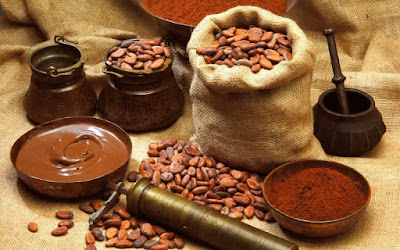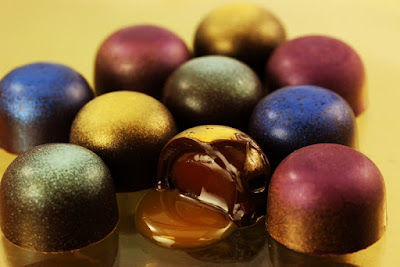If you're like many people, chocolate is not a luxury; It is a necessity. Often considered the fifth food group, chocolate has inspired one of the most popular love stories and passionate people with food. While the taste is just amazing, our fascination with chocolate since its discovery there over 2000 years included also other benefits. Chocolate has long been considered an aphrodisiac, a natural remedy for the blues, part of cardiovascular health (more recently), and even a form of currency. With its rich history and particular health and social importance, we are Recipe4Living think it's fair to include a chocolate guide. Satisfy your curiosity about the history of chocolate, how it is done, and how you can select, store and prepare the chocolate in your own home.
A brief history of chocolate:
Mayan beginning
Our chocolate obsession really began centuries ago with the Maya civilization of Mexico and Central America (250-900 AD). But the Mayan way of chocolates almost no resemblance to what we have today. Most Mayans grew cacao, the chocolate fountain in their courtyard, and harvested the seeds, which then fermented, roasted and ground. The word chocolate comes from the Aztec word "xocoatl" meaning the bitter drink. While most of the Mayas could enjoy the drink, chocolate was reserved for royalty, priests and other members of the upper class in the Aztec culture. Chocolate was an important part of the Aztec cocoa beans have become a form of currency.
The Spaniard added cinnamon, sugar and other spices for expensive imports, and kept his secret drink chocolate enjoyed by the Spanish nobility for nearly 300 years. Only in the 18th and 19th century when trade expanded sea and chocolate began to be mass-produced, could most of the middle-class wage chocolate. At the end of the 18th century, chocolate houses were as popular as coffee shops across England.
Chocolaterie
Unlike many delicate cocoa pods crop must be harvested by hand, making the chocolate creation process a laborious affair. The roasted seeds are cracked open to reach the peak or the heart, which is then ground into chocolate liquor (liquor). This thick liquid, made from cocoa butter and cocoa solids, is manipulated to create different types of chocolate.
Cocoa powder This form of chocolate, commonly used in cooking, is made from cocoa powder cocoa butter removed.
Unsweetened chocolate (Bitter / Chocolate Baking) - This is pure chocolate liquor unchanged, made from cacao 45% and 55% cocoa butter.
Bitter chocolate (semisweet) - Sugar, cocoa butter, lecithin, and vanilla are added to chocolate liquor to make this type of chocolate containing at least 35% chocolate liquor. semisweet chocolate bitter chocolate and sweeter are used interchangeably in the kitchen.
Coverage- This term is given to bittersweet and semisweet varieties of quality chocolate. Couverture contains a higher percentage of chocolate liquor (even 70%).
Dark chocolate (also called sweet chocolate by the US government) - No milk is added in the form of chocolate, which contains between 15% and 35% chocolate liquor. Dark chocolate is lighter in taste bitter chocolate and semi-sweet, even if it is dark.
This popular chocolate milk chocolate contains milk or form solids and 10% to 25% chocolate liquor. Chocolate milk is sweeter, softer and less bitter than the darker varieties.
White chocolate from white chocolate contains no cocoa, it really is not chocolate. White "chocolate" is made up of cocoa butter, vanilla, milk and sugar. It may not be chocolate, but it is always delicious.
Chocolate is good for you! Honestly ........!
* Mood Chocolate contains phenylethylamine the elevator, which is a mild mood elevator/anti-depressant and also happens to be the same chemical that our brain generates when we feel love or happiness. Chocolate contains other stimulants to "lift" your moods, such as caffeine, in very small quantities. In fact, one ounce of chocolate milk has about as much caffeine as a cup of decaffeinated coffee. Like chocolate, pepper, are considered an aphrodisiac for its intensity of taste and its ability to increase heart rate. In recent studies, flavonoids found in chocolate to regulate certain hormones essential for heart health and may have other immunomodulatory effects. Dark chocolate, which contains the highest concentration of cocoa liquor, is considered the best for your health. Dark chocolate contains about twice as many antioxidants as a milk chocolate bar.
Unlike many comfort foods, eating chocolate will not raise your cholesterol. Chocolate and cocoa butter contain saturated and unsaturated fats. But unlike a lot of saturated fats, stearic acid in chocolate is a neutral fat and not increase the bad cholesterol (LDL). The unsaturated fat in chocolate, oleic acid is the same kind of fat as olive oil, which can really help to increase good cholesterol (HDL).
Chocolate care
* Storage- chocolate should be stored in a cool, dry place at about 65-70 degrees F. It should not be refrigerated, as moisture will change the texture and appearance of chocolate. High temperatures cause a "flower" or "disorder" in the surface of the chocolate. This flower does not affect the flavour or chocolate frills, just the appearance. It occurs when the cocoa butter crystals melt and migrate to the surface of the chocolate.
* Chocolate Isolationism tends to absorb odours of any food around, which is another reason not to store chocolate in the refrigerator. Do not store chocolate in the same cabinet as onion, for example, because it will affect the taste of chocolate.
* Shelf-Most Cycle chocolate will keep for about one year if stored properly, and the darker varieties last longer. chocolates should keep for about a month.
* Humidity Do not add water to chocolate unless your recipe specifically calls for it. The water will harden the chocolate texture and consistency. Keeping this principle in mind when melting chocolate. Do not cover melt chocolate with a lid as steam will collect on the lid and fall in chocolate.
* Melt the chocolate because chocolate is very sensitive to heat, it is necessary to melt the chocolate slowly and removed from the heat. Always hot chocolate on low heat or it will quickly become an unsightly mass. Use a water bath, or place the pan with the chocolate on top of another pot of boiling water on the stove.
* Unsweetened Chocolate liquefy easily when melted, but the sweet chocolate must be stirred constantly.
* Chocolate flavoured coating contains cocoa and vegetable oil instead of cocoa butter.
* Cooking with chocolate try to avoid the chocolate with the butter fall. Instead, look for chocolate with a higher percentage of cocoa butter to maintain the quality of your product. When mixing different types of chocolate such as milk and bitter, using the same mark. Other chocolate recipes:
Chicken mole sauce
Turkey Mole
Chocolate Biscotti
Chocolate and Orange Swirl Muffins
Flourless chocolate cake
Diabetic Friendly Chocolate Cheesecake
The Ritz-Carlton chocolate cookie
Chocolate bars dream
Best Chocolate Brownies
Chocolate Espresso Torte
Mint Chocolate dreams
Lava Chocolate cake





0 komentar